Retirement Spending

Before you retired, you likely created a retirement savings plan to help you identify and reach your financial and lifestyle goals during retirement. Ideally this was done long before you retired and included a retirement spending plan that accounts for your goals and spans your investment time horizon.
If you’re currently retired and don’t have a retirement spending plan, don’t worry—it’s not too late to start. Whether you just retired and are forming a plan, or you’re long retired and reassessing your existing plan, we’ll address some essential retirement spending considerations to help you along.

Where Might the Market Go Next?
Confidently tackle the market’s ups and downs with independent research and analysis that tells you where we think stocks are headed—and why.
Ideally this was done long before you retired and included a retirement spending plan that accounts for your goals and spans your investment time horizon. You may want or need assistance from a trusted financial adviser to help you achieve your retirement goals.
Two Forms of Retirement Spending
Retirement spending falls into two categories: non-discretionary spending and discretionary spending.
Simply put, non-discretionary spending is for needs while discretionary spending is for desires.
For retirees, it’s essential to have a clear understanding of your spending in each category so you can help ensure your money will last throughout your entire retirement. It’s possible you may need to make some adjustments if expectations don’t match reality so you avoid running out of money during retirement.
Here we explore potential retirement costs, starting with non-discretionary expenses.
Non-Discretionary Spending
Certain expenditures are essential to daily living and hence unavoidable. You encountered these costs before retirement and continue to encounter them as a retiree, although they may be a bit different.
Non-discretionary expenses include living expenses, debt, taxes, insurance and healthcare. Because non-discretionary expenses are mostly predictable, planning for these costs is a good start and can help determine your discretionary spending budget.
Read on to learn more about the most common non-discretionary expense types.
-
Debt
-
Living Expenses
-
Taxes
-
Healthcare
Some retirees are debt-free and some still carry debt. Accounting for debt is an essential component of a retirement spending plan. Regular payments must be factored in as part of your non-discretionary spending. You may have a mortgage, credit card debt or a car loan. For every debt, also bear in mind you’re paying interest on top of the principal amount you must repay.
Most retirees have unavoidable living expenses during retirement like housing, utilities, groceries and transportation. Some of these expenses might be significantly different than before you retired. But even if you own your home outright, you’ll incur costs for repairs or improvements, and you’ll still pay utility bills.
As a retiree, your taxes may be lower than they were before you retired as your tax rate shifts from earned income to dividend and interest income along with capital gains. Nevertheless, the government still wants its cut, so you should plan to set aside enough money to settle your estimated tax bill each year.
Using tax-advantaged retirement accounts like a Roth IRA can potentially reduce your tax burden. Ask your tax professional to help you determine your estimated tax bill each year and plan expenses accordingly.
Healthcare may take up a larger portion of your budget as you grow older. And healthcare costs have historically risen faster than inflation.1 This is an area where you may encounter more retirement spending than you anticipate. It is important to factor healthcare costs into a retirement spending plan—both insurance premiums and out-of-pocket costs—and expect those costs to grow over time.
The preceding non-discretionary spending types are all necessary expenses that may change over the course of your retirement, but you will likely always have non-discretionary spending obligations.
Depending on your goals, there may be more to retirement spending than just the basic necessities. You’ll want to consider and plan for items that might not be essential bur are an important part of enjoying your retirement.
Let’s now consider common discretionary expenditures during retirement.
Discretionary Spending
Discretionary expenses are deemed nonessential and include smaller costs like a cable TV subscription to larger costs such as a vacation home or leaving a legacy to your family or charity. These expenses may not be considered essential to living daily life, but they’re significant when it comes to enjoying your retirement.
Discretionary spending may change over time, and maintaining control over these expenses is important to fulfill your retirement goals. Depending on your non-discretionary spending, you may need to make adjustments to your discretionary spending as in theory you have more flexibility with those expenses.
Let’s review some common forms of discretionary spending.
-
Travel
-
Hobbies
-
Luxuries
-
Children and Grandchildren
Some retirees plan to spend time traveling. This can mean visiting family, trekking across the country or taking trips overseas. If you plan to travel during retirement, don’t forget to account for the expenses involved. Relative to your pre-retirement travel, you may see an increase or decrease in travel spending.
Retirement is a perfect time to rekindle old hobbies or to spend time acquiring new ones. Whether you plan to put together an in-depth compilation of your family history, study art, go fly-fishing or play golf, hobbies often incur costs.
What is considered a luxury is subjective. It can be simple, like meeting your friends for coffee every morning. Or it can be more involved, like joining a country club. Whatever a luxury means to you, its costs should be part of your retirement spending budget.
Perhaps you plan to spend more money on your children or grandchildren through travel costs, education expenses, gifts or by passing on a legacy. Perhaps all of the above!
In summary, for each discretionary spending case, it’s important to consider how much growth, income or cash flow these goals will require from your investments. Be prepared to make some tough decisions on your discretionary spending if your non-discretionary obligations can’t be met.
Inflation and Time Horizon
Your retirement spending and saving are impacted by inflation and your investment time horizon, so it’s important give heavy weighting to these considerations when you’re planning.
-
Inflation
-
Investment Time Horizon
-
Regular Plan Reviews
Inflation is defined as a general increase in prices. This increase reduces your purchasing power over time. Inflation rates vary annually but average approximately 3% per year.
That may not sound like much. But if that inflation rate continues and you need $50,000 now to cover annual living expenses, you’ll need about $90,000 in 20 years and about $120,000 in 30 years to cover those same expenses. It is important to be aware of inflation’s impact on your retirement spending plan.
Your investment time horizon is, put simply, how long you need your money to work towards your retirement goals. Factoring in your investment time horizon is essential to determining your total retirement costs.
Your investment time horizon may be the same as your life expectancy, or it may extend beyond your life if you want to leave a legacy. Regardless, your life expectancy and that of your partner’s plays an important role in a retirement spending plan.
Many people are living longer because of medical advances. To be safe, prepare to live a long time—longer than you expect—so you don’t run out of money during retirement, which may mean returning to work or perhaps making other tough choices. If you and your partner have different life expectancies, use the longer of the two to be safe.
If you haven’t already, perhaps speak with a financial planner to determine your investment time horizon and therefore how to best plan your retirement spending.
As most retirees know, spending habits throughout retirement can change as your financial needs and retirement goals change. Reviewing your retirement spending plan on a regular basis will help identify areas that need attention before they get out of control and keep your overall retirement plan on track.
If you don’t already have a budget, create a list of discretionary and non-discretionary expenses. Review your expenses with your financial planner. Reconcile your investment allocation with your desired income/cash flows and your investment time horizon to ensure you have the best possible plan for your situation.
Ensuring a successful retirement involves planning throughout your retirement years with a critical look at your discretionary and non-discretionary spending. Your non-discretionary expenses aren’t easy to adjust, but your discretionary expenses can and should be adjusted if you’re having trouble meeting essential living expenses in retirement.
Thorough planning for what you can predict, and building in a safety net for the unpredictable, will help you on your path to a successful, enjoyable retirement.
Do You Need Help with Your Retirement Planning?
Retirement planning requires a holistic view of your anticipated spending needs and financial goals. Weighing all the aspects of retirement planning, saving and spending is not always easy. You may want or need assistance from a trusted financial adviser to help you achieve your retirement goals.
Fisher Investments may be able to help. Contact us today to learn more about planning for your retirement spending.
1Source: FactSet, as of 01/09/2018. Consumer Price Index data from 12/31/1990-12/31/2017.




